My name is Patrick Bateman. I’m 27 years old. I believe in taking care of myself, and a balanced diet and a rigorous exercise routine. In the morning, if my face is a little puffy, I’ll put on an ice pack while doing my stomach crunches. I can do a thousand now. After I remove the ice pack I use a deep pore cleanser lotion. In the shower I use a water activated gel cleanser, then a honey almond body scrub, and on the face an exfoliating gel scrub. Then I apply an herb-mint facial masque which I leave on for 10 minutes while I prepare the rest of my routine. I always use an after shave lotion with little or no alcohol, because alcohol dries your face out and makes you look older. Then moisturizer, then an anti-aging eye balm followed by a final moisturizing protective lotion. There is an idea of a Patrick Bateman. Some kind of abstraction. But there is no real me. Only an entity. Something illusory. And though I can hide my cold gaze, and you can shake my hand and feel flesh gripping yours, and maybe you can even sense our lifestyles are probably comparable, I simply am not there.

American Psycho is twenty years old, and somehow more relevant than ever.
To be fair, the film signposts this strange relevance. Towards the end of Bret Easton Ellis’ novel, Bateman takes a moment to muse on Trump Tower, admiring it as it stands “tall, proudly gleaming in the late afternoon sunlight.” Throughout the film, Bateman and colleagues are obsessed with Trump. “Is that Donald Trump’s car?” asks Bateman while riding with his fiancée in a taxi. Later on, out at dinner in a low-rent restaurant, he tries to catch a colleague’s interest (and maybe his own) by asking, “Is that Ivana Trump?”

Without ever being directly present in the film or the novel, Donald Trump haunts American Psycho. Ironically, that weird relationship has only deepened in the years since the novel was published and the film was released. During his presidential campaign, Trump famously boasted, “I could stand in the middle of Fifth Avenue and shoot somebody and I wouldn’t lose any voters.” It’s an argument that has become worryingly central to Trump’s campaign, with even his lawyers advancing the argument that he couldn’t be prosecuted for it as part of an argument over his tax returns.
American Psycho makes a similar argument about its protagonist. Bateman spends the entirety of the book and movie openly boasting and threatening characters with death and dismemberment, only for everybody involved to remain either willfully or accidentally ignorant of what Bateman claims to be. Bateman confesses his crimes repeatedly and openly, only for colleagues to laugh it off as a joke or shift the conversation or reveal that they weren’t really listening. American Psycho unfolds in a world where nothing is real and nothing matters. It is closer to our world than it seems.

On the surface, American Psycho looks and feels a lot like a slasher story. This is perhaps more obvious in Ellis’ source novel, which is populated with grotesque details of Bateman’s murders that are left largely implied within Mary Harron’s cinematic adaptation. To be fair, the decision to downplay some of the more graphic illustrations of Bateman’s monstrosity is a practical choice. Even in prose, some of these sequences are too much, and putting them on screen would seem gratuitous and excessive even beyond the film’s celebration of gratuitous excess.
Nevertheless, American Psycho borrows a certain amount of cinematic language from the slasher film. After all, Bateman positions himself as a fan of serial killers like Ed Gein and Ted Bundy. His name evokes an even more generic riff on “Norman Bates” from Psycho. Harron’s adaptation is certainly no afraid of blood and guts, often splattering actor Christian Bale with red dye. Dismembered body parts appear at various points. The film even offers a few traditional jump scares.
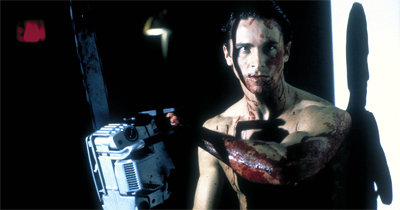
Much of the film’s aesthetic riffs on the iconography of a certain kind of horror film, somewhere between the slasher movie of the late seventies and the so-called “torture porn” of the early millennium. One of the video tapes that Bateman keeps on hand is Texas Chainsaw Massacre, and one late sequence allows Patrick to play that out. The film devotes a great deal of attention to the instruments of Bateman’s sadistic pleasures: the pick axe, the nail gun, the rain coat, the duct tape, the chainsaw, the coathanger.
However, Harron makes a point to play these slasher elements as a pitch black comedy. There are few images that so effectively summarise the aesthetic of American Psycho as Bateman chasing one of his victims through an apartment complex with a chainsaw, naked apart from a set of bright white runners. Similarly, there’s something inherently absurd about the image of Bateman dressed in a raincoat and primed for a kill, pausing to explain the beauty of Huey Lewis and the News to his intended victim.
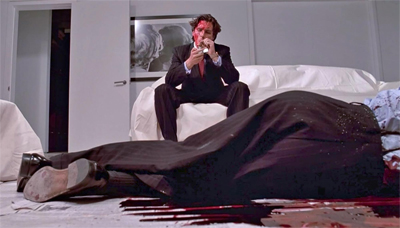
Indeed, one extended sequence involving Bateman’s besotted secretary Jean plays as an elaborately grim joke about Bateman’s impotence. He has invited the young woman back to his apartment with the intention of murdering her, but can’t seem to get excited about it. He takes out the duct tape, and timidly places it back. “I need it to tape something,” he awkwardly explains. When she almost places a sorbet-covered spoon on his glass table, he gets excited enough to take out the nail gun and point it at the back of her head, but he just can’t bring himself to do it.
After all, the central point of American Psycho is that all of this brutality exists within Bateman’s imagination. This is his own fantasy and his own indulgence. Towards the end, it becomes clear that Bateman hasn’t necessarily murdered anybody at all, just filled his diary with a smorgasbord of monstrous images depicting his dreams of playing at being a serial killer. When Bateman confesses to murdering Paul Allen, a colleague insists that this is impossible. Allen actually is in London, and is perfectly fine.
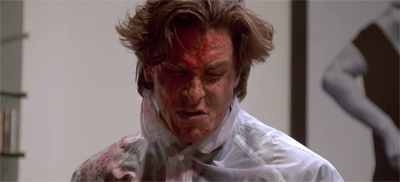
As such, the juxtaposition of horror and comedy within American Psycho plays as a clever way of deflating Bateman’s fantasy, revealing that even his most blood-soaked and sordid imaginings are inherently ridiculous and pathetic. The murders are ultimately no different from the sex scenes that he films with prostitutes, emulating the pornography that he watches in his spare time. Bateman’s fantasies are entirely self-involved. He films these sexapades so he might watch himself, even becoming lost in his own reflection during the act itself. It’s all empty and pointless.
This gets at the real horror in American Psycho, the simmering anxiety that nothing is real. There’s a creeping sense of existential horror running through the novel and the film, which occasionally seems vaguely Lovecraftian in nature, a sense that there’s something truly monstrous slithering beneath the skin of the world and that to perceive it would be to invite madness. Throughout the film, there are two fascinating competing realities at play: Bateman’s status as narrator and protagonist, set against the building sense that Bateman may not actually exist.

There’s a sense of meaninglessness to all of this. Bateman is not exactly subtle about his desires and his personality. When a waitress informs him that he will have to pay for his drinks, he smiles as he hands over the cash. As she turns her back, he rambles, “You’re a f%!king ugly b!tch. I want to stab you to death and play around with your blood.” Later on, at a nightclub, he tells another woman that he’s into “murders and executions.” She responds, “Most guys I know who work in mergers and acquisitions don’t really like it.”
Part of this is just an extension of the self-absorption of the eighties. Bateman’s fantasies reduce other human beings to objects for his own sadistic pleasure, so it makes sense that other characters would reflect that attitude back at him. At one point, Bateman’s attempt to murder Luis Carruthers gets mistaken for a homoerotic come-on, Carruthers indulging his own self-centred fantasies. “You can’t imagine how long I’ve wanted this,” Carruthers assures his colleague.
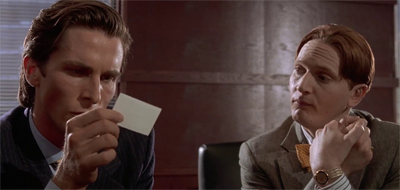
Bateman is naturally horrified by this, panicking and running away. Bateman’s panic is most obviously an expression of his homophobia, but it perhaps reflects his deeper discomfort at being somebody else’s fantasy object. Indeed, it’s heavily implied that Bateman resents his fiancée Evelyn because she treats him as an object to play out her own fantasies of a happy life. Bateman becomes distinctly uncomfortable when Evelyn points out that his father “practically owns the company”, suggesting that Bateman’s success is simply inherited rather than earned.
One of the grimmest jokes in the film is that Bateman seems to be completely unremarkable. Characters frequently confuse him with other people, which makes sense given that so many of the men working on Wall Street adhere to the same styles. Paul Allen consistently confuses Bateman with Marcus Halberstram. “It seems logical because Marcus also works at P & P, and in fact does the same exact thing I do,” admits Bateman. “He also has a penchant for Valentino suits and Oliver Peoples glasses. Marcus and I even go to the same barber, although I have a slightly better haircut.”
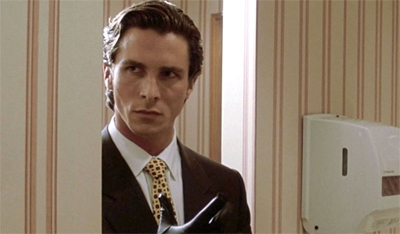
However, it isn’t just Paul Allen. At the climax of the film, fleeing the authorities, Bateman desperately flees into a random office complex in the financial district. The security guard seems to recognise him. “Burning the midnight oil, Mister Smith?” the guard asks, right before Bateman shoots him and flees to his own office within an identical building just a little bit further away from the scene of the crime.
American Psycho is a world of mirrors, a hallow space populated by empty figments. It is a universe of clones and copies, duplicates and doppelgangers. In its own way, it is a reflection of that same existential ennui that ran through contemporaneous films like The Truman Show or The Matrix or The Sixth Sense. It just happens to be heightened and pushed to extremes, filtered through the cocaine haze of late eighties excess.
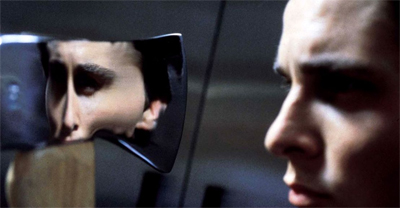
Indeed, this eighties aesthetic allows American Psycho to push a little bit further than films like The Thirteenth Floor or Dark City. After all, those millennial meditations on simulations and simulacra at least remained certain that some of the characters actually existed. There had to be characters like Thomas Anderson or Truman Burbank to perceive the shadows of reality projected onto the cave wall. American Psycho goes a great deal further than that, suggesting that Bateman himself doesn’t actually exist in any material sense.
Bateman himself admits as much early in the film, as he meditates upon his daily beauty routine. “There is an idea of a Patrick Bateman,” he explains to the audience. “Some kind of abstraction. But there is no real me. Only an entity. Something illusory. And though I can hide my cold gaze, and you can shake my hand and feel flesh gripping yours, and maybe you can even sense our lifestyles are probably comparable, I simply am not there.” This is very true. Bateman isn’t a person in any sense beyond basic biology. To underscore the point, the voiceover plays as he peels off a facemask.
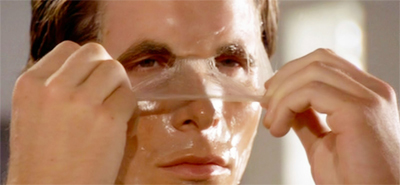
The film and the novel reiterate this in a number of ways. Most obviously, Bateman seems entirely incapable of independent thought. He is tasteless, but not because he has bad taste but because he has no taste. Bateman relies on a constant stream of sensory input to shape his awareness of the world. He is rarely seen without his walkman and his earphones, even during car rides with his fiancée. Even his fantasies of sex and violence are ported over wholesale from the porn and horror movies that he watches.
It’s debatable to what extent Bateman is capable of formulating his own opinions. Dining with his mistress, he tells her, “Courtney, you’re gonna have the peanut butter soup with smoked duck and mashed squash. New York Matinee called it ‘a playful but mysterious little dish.’ You’ll love it.” Spoken with enough authority, his assertion of a regurgitated opinion might be mistaken for his own. The illusion of Patrick Bateman might be maintained.
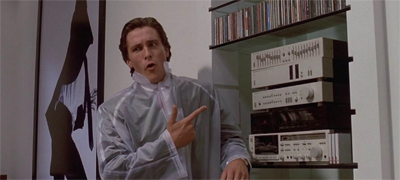
Ellis punctuated the novel with extended digressions on the pop culture of the eighties, allowing Bateman to offer blackly comic critical takes on performers like Phil Collins and Whitney Huston. In the book, the joke was that these takes were hilariously awful, to the point that it was almost impossible to believe that a human brain could have constructed them. However, Harron and Bale escalate the joke by incorporating some of these digressions into dialogue.
Repeatedly over the course of the film, Bateman subjects his guests to his critical dissection of contemporary pop culture. The joke seems to be that whatever physical sadism Bateman has planned will be more enjoyable than being subjected to a lecture on Huey Lewis and the News. For Bateman, these lectures are part of the point, a way of validating himself. He pays bored prostitutes to listen to him with barely-concealed boredom as he works through the importance of Invisible Touch in the context of Genesis’ discography.
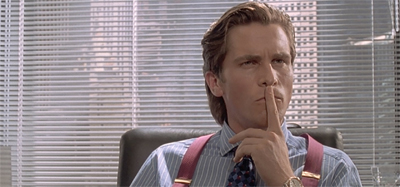
Bale plays these scenes like a robot reading an encyclopedia, which adds another level to the joke. Ellis seems to suggest that Bateman had somehow formulated these opinions by himself, like some sort of grotesque critical Turning machine. However, Bale plays these sequences as if Bateman is reading Shakespeare. It seems very clear that Bateman is not articulating his own opinions, but simple reiterating something that he was told or had read somewhere else. Bateman wants his victims to appreciate his keen critical ear, but it feels very much like his voice has been stolen.
The result of all of this is to imply that Patrick Bateman is just a hollow sculpture in the shape of a person, a black hole dressed in a skin suit. It isn’t even accurate to compare him to the creatures impersonating human beings in movies like Invasion of the Body Snatchers or Under the Skin, because in those movies there is at least some indication that there’s something underneath the surface veneer. “I have all the characteristics of a human being: flesh, blood, skin, hair,” he insists, “but not a single, clear, identifiable emotion, except for greed and disgust.”
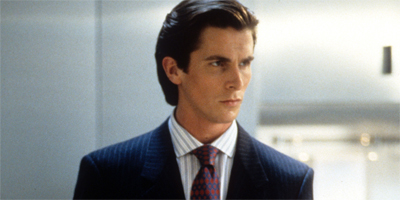
There is something primal and horrifying within all of this, the implication that neither the world around Bateman nor Bateman himself could be considered “real” by any conventional understanding of the term. American Psycho suggest a fundamental existential terror working its way through Bateman, a sense of a world so devoid of meaning that even the eyes staring at that world are meaningless. As Bateman explains at the end of the film, “I gain no deeper knowledge of myself; no new knowledge can be extracted from my telling. This confession has meant nothing.”
There is something very bleak in all of this, an expression of a nightmare that seems to foreshadow the “post-truth” world that would be ushered into being by Bateman’s idol. It is a world without meaning and without consequence, in which a New York financial figure could murder somebody in the middle of fifth avenue and escape without punishment or indictment. There’s an intentional and pointed hollowness to American Psycho, depicting a world perched atop a dark and empty void – separated by only the thinnest of veils.

As Bateman’s mania overtakes him, as his fantasy begins to crack and the faintest glimmers of reality threaten to intrude, he gasps, “My mask of sanity is beginning to slip.” Twenty years later, if feels like the mask has completely fallen away.
Filed under: On Second Thought | Tagged: american psycho, christian bale, horror, mary harron, nightmare, parody, patrick bateman, satire |




















As a fan of Phil Collins’ era Genesis, I curse this book/movie’s existence, because people think they’re *so* fucking clever when they quote it!
Ha! To be fair, South Park also probably contributed to Collins’ decline in pop culture around the same time. It would have been around the same time as the release of the film version of American Psycho.